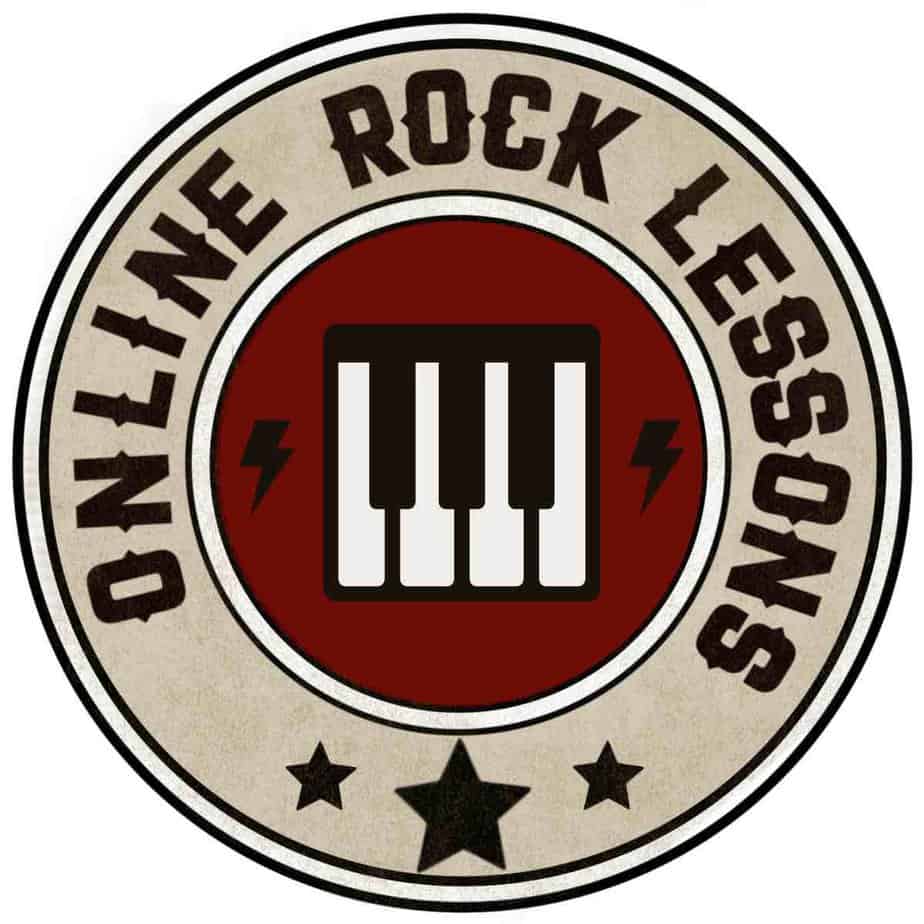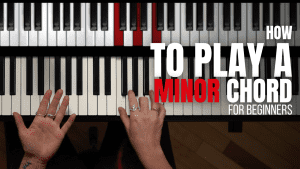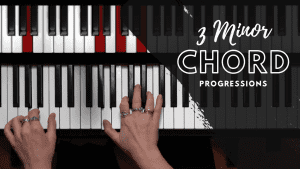In this lesson, we will learn how to play three super useful left hand grooves to play at the piano.
The grooves are in the key of D minor, which has one flat note (Bb) and will be based on the chord progression i-VI-III-VII. In the key of D minor, the chords of this progression are Dm, Bb, F and C.
Groove #1:
The first groove is fairly simple. It is a mix of half notes, quarter notes and eighth notes.
Since the goal of today’s exercise is to practice grooves played by the left hand, the right hand only plays simple chords in whole notes to create a harmonic support.
The left hand follows a specific formula throughout the whole chord progression. For this groove, we need the notes of the first and fifth degree of our chords. Let’s find the notes of these degrees for the D minor chord. The note of the first degree of the D minor scale is D and the note of the fifth degree of the D minor scale is A. Let’s find the notes of the degrees of the F chord. Its first degree is F and its fifth degree is C.
The rhythm of this groove is as follows : quarter note, eighth note, eighth note, half note. In our progression, we spend two beats on each chord. So, we play the quarter note and the two eighth notes with the notes of the first and fifth degree of the D minor chord (D and A). Then, we move on to the half note played with the note of the first degree of the Bb chord. We repeat this pattern with the two remaining chords of our progression, F and C. The quarter note and the two eighth notes are played with the notes of the first and fifth degree of the F chord (F and C). Then we move on to the half note played by the first degree of the C chord (C).
Here is our groove #1 written down:

Groove #2:
The second groove is used very often in different genres. It is emulating what the bassist often plays in a group. The rhythm of this groove is as follows: dotted quarter note, eighth note, half note.
In this groove, we stay all four beats on each chord of the progression and we only use the note of the first degree of each chord.
The right hand keeps playing chords in whole notes for harmonic support.
The left hand plays the rhythm. On the D minor chord, we play the dotted quarter note, the eight note and the half note with a D. Then, on the Bb chord, we play the dotted quarter note, the eight note and the half note with a Bb. For the F chord, we play the dotted quarter note, the eight note and the half note with an F and finally for the C chord, we play the same rhythm but with a C.
Dotted quarter notes may be new to you. If so, it is very important to internalize this new rhythm by counting out loud “1 – and – two – and – three – and – four – and” while playing the groove. You can even start by clapping the rhythm with your hands while counting out loud “1 – and – two – and – three – and – four – and”. The dotted quarter note falls on the “1”, the quarter note falls on the “and” of the 2 and the half note falls on the “3”.
Here is our groove #2 written down:

Groove #3:
The third groove is an arpeggiated accompaniment. This type of groove sounds particularly great on the piano. The rhythm of this groove is all quarter notes.
The right hand is still playing chords in whole notes to ensure harmonic support
The left hand follows a specific formula throughout the whole progression. We use the degrees I-V-I-V-III-V-I-V (make sure to look at the sheet music of this groove to play it correctly since the degrees can be played on different octaves) which are based on the scale of every chord of the progression. The notes of the I-V-I-V-III-V-I-V pattern in D minor are D-A-D-A-F-A-D-A. The notes of the pattern of the Bb chord are Bb-F-Bb-F-D-F-Bb-F. The notes of the pattern of the F chord are F-C-F-C-A-C-F-C. Finally, the notes of the pattern of the C chord are C-G-C-G-E-G-C-G.
Here is our groove #3 written down:

You now know three new ways to play accompaniments with your left hand. Make sure to transpose them in all keys and try different progressions to really master your grooves!
Text Transcription by Andreane Boucher

Founder of Online Rock Lessons, Marine is the keyboardist for Uncle Kracker, Corey Hart and Highway Hunters.
With over 20 years of experience in show business, Marine is launching the first Canadian Music School dedicated to rock and blues lovers.






Questions